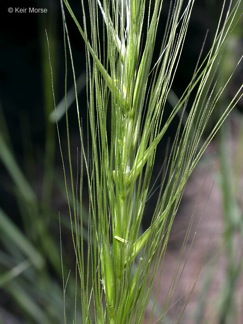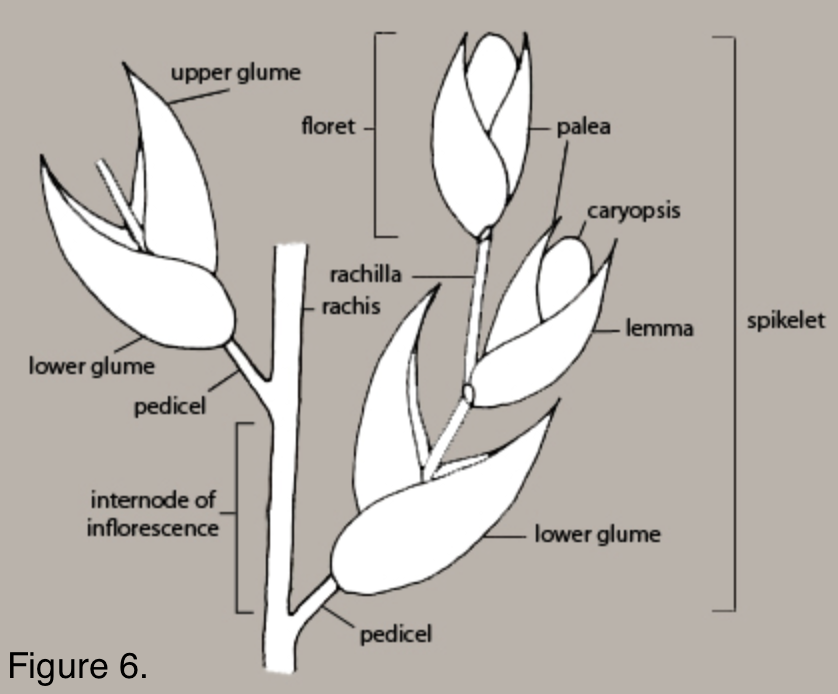Form and Function
Size and appearance:
E. elymoides is a grass, and all grasses have narrow leaves that grow out from a base
(Simonin 2001). E. elymoides has a height growth between
10 and 45 cm tall where hollow stems, culms, protrude out from
the base of the grass. The leaf blade thickness is anywhere from
flat to curved ranging
 from
1 to 6 mm; whereas the complete flower head, or inflorescence of
the grass, is a spike ranging from 2 to 17 cm long not counting
the bristle-like structures at the end of the leaf. The
internodes on each inflorescence structure are between 2 to 10
mm with branching on each side of the stem. The bristle-like
structures that grow out from the leaves are anywhere from 2 to
10 cm long, and often become purple as the plant matures (USDA
2006). To get a better idea of what E. elymoides looks
like, the image to the left and the diagram below gives you an idea of what the bristle-like
structures look like as well as the size and appearance of the
inflorescence (figure 6). Furthermore, the awns (bristle-like structures)
help protect the plant from getting eaten by certain grazing animals
because they puncture flesh around the mouth which causes
irritation and could potentially cause eye or ear injury
(Simonin 2001).
from
1 to 6 mm; whereas the complete flower head, or inflorescence of
the grass, is a spike ranging from 2 to 17 cm long not counting
the bristle-like structures at the end of the leaf. The
internodes on each inflorescence structure are between 2 to 10
mm with branching on each side of the stem. The bristle-like
structures that grow out from the leaves are anywhere from 2 to
10 cm long, and often become purple as the plant matures (USDA
2006). To get a better idea of what E. elymoides looks
like, the image to the left and the diagram below gives you an idea of what the bristle-like
structures look like as well as the size and appearance of the
inflorescence (figure 6). Furthermore, the awns (bristle-like structures)
help protect the plant from getting eaten by certain grazing animals
because they puncture flesh around the mouth which causes
irritation and could potentially cause eye or ear injury
(Simonin 2001).
E. elymoides is able to tolerate moderate fires because of its rough texture, small size, and very little leafy material that is difficult to catch fire (Simonin 2001). The likelihood for E. elymoides to catch fire increases as the amount of dead and dry material increases from previous years growth, but because the fire burns quickly, the crown, or base of the plant, is not damaged and is able to regenerate back the way it was. It is possible, however, to kill the grass with extreme heat where it will kill the crown (USDA 2006). E. elymoides is able to regenerate mainly because of its carbohydrate reserves in its roots. As you can see from the image below carbohydrate reserves are highest in later summer (anthesis) or the middle of fall before it starts to regrow (Simonin 2001).
Adaptations to environment:
E. elymoides is a species that has adapted well to
various environmental conditions. This grass can be found at
altitudes ranging from 2,000 to 11,500 feet in desertous or
mountainous locations (USDA 2006). Little annual precipitation
is needed for this grass to survive due to the lengthy roots
that burrow through the soil. The root depth for E. elymoides
was found to be 100 cm and the lateral, or horizontally
extending, roots have been seen to reach the same length
(Simonin 2001). Not to mention, these roots are incredibly
strong and resistant, not only burrowing through loose, fine,
coarse, ashy, and gravelly soils, but the roots of this grass
are able to withstand moderately saline to alkaline soil (UDSA
2006 and Simonin 2001). Additionally, E. elymoides is able to
stop its seeds from germinating during dry weather conditions by
entering a stage of dormancy (Simonin 2001). This helps the
grass become more efficient and slows growth during unfavorable
conditions.
Movement:
E. elymoides is a grass which means it is fairly limited to
moving around, but its seeds are able to be scattered around by
the wind thanks to the awns which help catch the wind. The seeds
scatter when the spike, a flower-like head at the end of the
stem, falls off and the awns catch the wind to help drag it
across the ground as the seeds continuously fall off along with
way (Simonin 2001).
Furthermore, it is important to note that E. elymoides when
grouped in multiples of its own species helps to control soil
erosion from not only water, but wind erosion as well. E.
elymoides does an excellent job in erosion control because
of how long its roots are as mentioned above (USDA 2006).
Go back to the
Habitat and Geography page, or continue on to the
Life/History Reproduction page.
Return to Home Page

